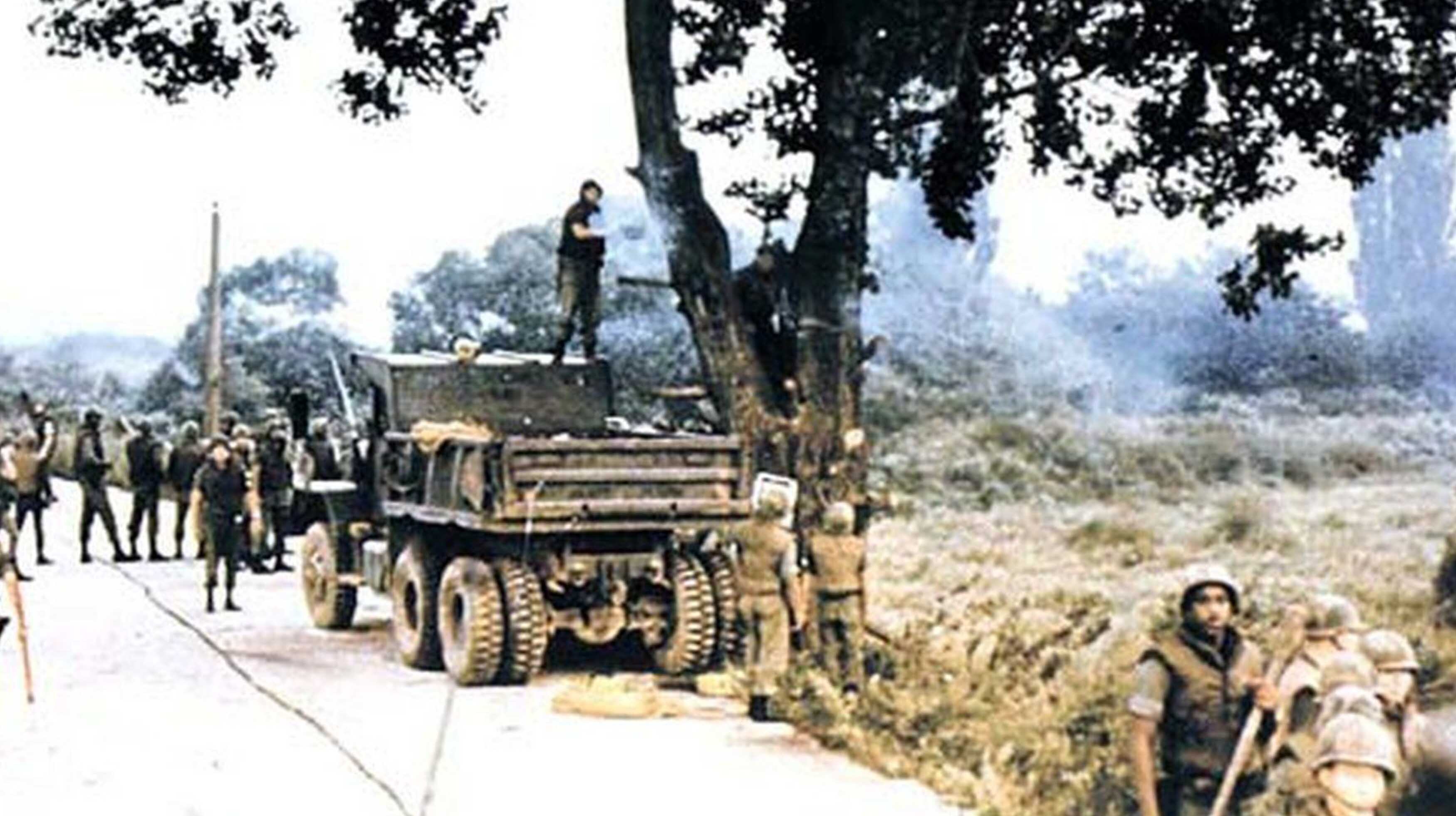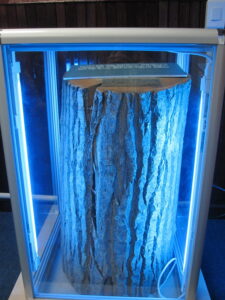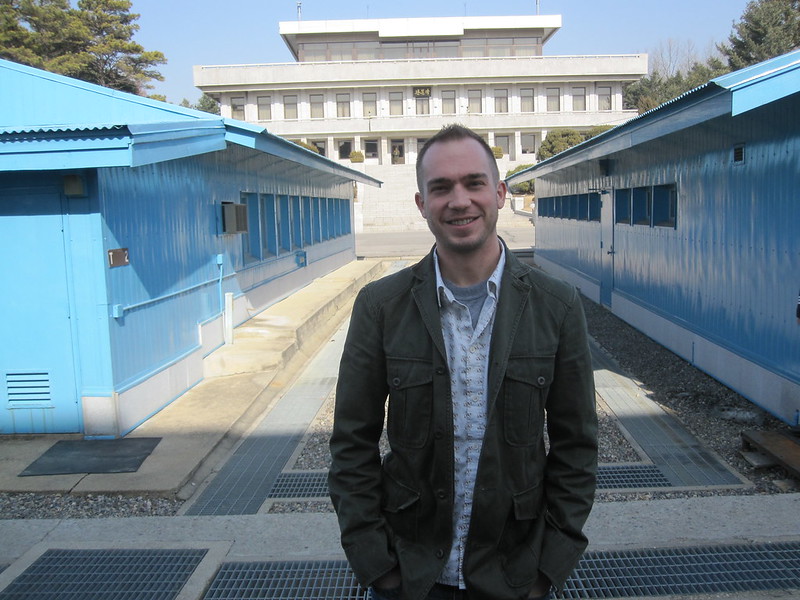Operation Paul Bunyan: The Most Expensive Tree Trimming in History
In 1976, a skirmish at the Demilitarized Zone between North and South Korea led to the brutal murders of two Americans. The skirmish began over the trimming of a tree. The result was the most expensive tree-trimming in history. America and South Korea returned to the tree with all of their military might in a show of force. In this episode, I’ll tell you a story about the DMZ that you may have never heard. And then we play the quick quiz!

On the last day of a nearly month-long tour performing for the troops in Korea, we toured the Joint Security Area of the Demilitarized Zone between North and South Korea. This is a closely watched area of the DMZ where it’s common to see North Korean and South Korean troops standing at attention just steps away from each other. I always describe the tour there as a really strange combination of active war zone and tourism. Razor wire fences and tour buses. Machine guns and photo opportunities. The War in Korea was never won or lost or declared over. It’s just on a 68 year cease-fire. And every once in awhile, tensions between the two countries flare. Like in 2017, when North Korea fired on a defector as he escaped the country.

By the way – the area where that happened is exactly where I stood 7 years before. The Joint Security Area – sometimes referred to as “Truce Village” or more correctly Panmunjom is a large area in the middle of the DMZ where UN Security Officers led us on a tour of the region. Before that tour, we had to have a briefing telling us what we could and couldn’t do. And in that briefing room, encased in glass, is a tree trunk. A small brass plaque in Korean and English is attached to the top of the trunk. It reads: “This is a piece of the tree over which two UNC officers were murdered by North Korean guards 18 August, 1976.”
It was that poplar tree that began the entire incident in 1976. Throughout the DMZ, there are a series of observation posts and checkpoints. You can see these buildings throughout the Joint Security area and the two buildings that we’ll be talking about are two that are near a small bridge. The bridge has a significant history – it was used for prisoner exchanges at the end of the Korean War and it’s known as “The Bridge of No Return.” Near that bridge is a road and a United Nations Checkpoint – called CP Number 3. Not far away from that was Observation Post number 5. And during the winter months, there was a clear view of CP Number 3 from the observation post. But by summer, when the leaves were full on the trees, you could only see the very top of the Checkpoint building. In particular, there was one poplar tree that had grown up to be 40 feet-tall and was obstructing the view.

Now at this point, it’s probably important to provide a small backstory. I said the incident started with this tree, but there is a little bit more than that – in 1976, it had been more than 20 years since the armistice at the end of the Korean War, but tensions were still high. A couple months prior to the tree incident, a North Korean soldier got into a fight with an American officer and Captain Arthur Bonifas, who had just arrived at Camp Liberty Bell – the camp on the American side of the Joint Security Area, had to break the fight up. After that, a group of American Soldiers had been held at gun point by North Korean soldiers and once again, Captain Bonifas had to step in and settle the matter. So by the time Captain Bonifas showed up to supervise a group of people to trim the poplar tree, there was already some bad blood from recent events. They had been requesting for the tree to be trimmed and their requests were denied by the North Koreans.
On August 18th of 1976, Captain Bonifas and his South Korean Army counterpart, Captain Kim, arrived with 11 American enlisted men, their platoon leader, First Lieutenant Mark Barrett, and a group of five Korean Service Corps personnel. They showed up in a truck with axes and picks to trim the tree and began to get to work.
Before they could complete the trimming, a truck rushed in full of 15 North Korean guards. Their lieutenant, Pak Chul, demanded that they stop trimming the tree. He yelled to Bonifas, “The branches that are cut will be of no use just as you will be after you die.” Bonifas had been trained to ignore threats from the North Korean guards, who were always looking for reasons to say the Americans were the aggressors. So he continued to oversee the trimming of the tree while Lieutenant Pak sent for 30 more soldiers. So as Captain Bonifas turned his back to the North Koreans, Lieutenant Pak removed his watch, wrapped it in a cloth and put it in his pocket. Another North Korean officer began rolling up his sleeves. They were preparing to fight.
North Korean Lieutenant Pak Chul was known as “Lieutenant Bulldog” because of his history of starting fights and being difficult to work with. As the 40 foot poplar tree was being trimmed, he yelled “Kill the bastards!” And began running toward the Americans and South Koreans. His soldiers picked up the tools being used to trim the tree and started attacking. Their first target were the leaders of the group, thinking they could stop them from ordering a counter-attack.
At least 5 Korean Guards attacked Captain Bonifas with an axe and various tools, beating him to death on the ground. Another group attacked Lieutenant Mark Barrett, who was attacked, then jumped over a wall to escape and fell 15 feet. The entire attack only lasted about 30 seconds. Almost every person sent to trim the poplar tree sustained injuries. They placed Bonifas in the back of the truck and retreated to safety, but couldn’t find Barrett. It turns out the North Koreans had been taking turns going down into the depression where Barrett was lying and hitting him with an axe. By the time he was recovered, it was too late. He died on the way to the hospital.
I’m telling you the story the way it really happened. But here’s how it was reported that day in North Korean media:
“Around 10:45 a.m. today, the American imperialist aggressors sent in 14 hoodlums with axes into the Joint Security Area to cut the trees on their own accord, although such a work should have mutually consented beforehand. Four persons from our side went to the spot to warn them not to continue the work without our consent. Against our persuasion, they attacked our guards en masse and committed a serious provocative act of beating our men, wielding murderous weapons and depending on the fact that they outnumbered us. Our guards could not but resort to self-defense measures under the circumstances of this reckless provocation.”
The result of this attack is the true story here. It was called the most expensive tree-trimming operation in history, and is one of the untold truly great moments of Gerald Ford’s Presidency. If you consider the political situation of the time, Ronald Reagan had just challenged Gerald Ford for the Republican nomination for President and one of the things he used to hit Ford on was that he was weak on Communism. Ford had pardoned draft dodgers from the Vietnam War and he needed to look tough on foreign Communist powers.
Secretary of State Henry Kissinger went to China to make sure they’d put their foot down on North Korea if needed. He said, quote “We cannot permit the principle to be established that Americans can be assaulted with impunity.” They also met with the President of South Korea to make a statement.
Jointly, they decided to go back and trim the poplar tree, but to do it in a huge way that would show North Korea the force of the combined military strength they were dealing with. If Kim Il Sung wanted to send a message, the United Nations Command with the power of the United States Military, would send an even stronger one. It was called Operation Paul Bunyan and it was scheduled to happen just 3 days after Captain Bonifas and Lieutenant Barrett were killed.
It’s amazing the amount of force that was scrambled in just 3 days. The tree trimming would be conducted with a convoy of 23 trucks and military road vehicles, supplied by both the South Korean and American Armies. Two 30-man platoons provided back up to these forces with guns and clubs. The bridge was rigged with explosives in case the North Koreans started driving trucks in their direction. Circling overhead in the air were 20 utility helicopters, 6 Cobra attack helicopters, several nuclear-capable B-52 Bombers sent from Guam, escorted by American F4 Phantom Fighter jets, a dozen C-130 gunships and South Korean F-5 and F-86 Fighters. The aircraft carrier USS Midway had been moved to a defensive position just off shore of the DMZ. Just outside the DMZ, military battalions prepared hawk missiles aimed at North Korea. Thousands of troops prepared at their bases throughout South Korea just in case this led to war. Camp Liberty Bell was rigged with explosives in case North Korea attacked and took over the base. It was the most expensive tree trimming in the history of the world.
Operation Paul Bunyan was a success if the objective was trimming a tree. The entire tree was chopped down. It was also a success if the objective was getting North Korea to apologize. After seeing the military might displayed to trim the tree during the operation, North Korean Leader Kim Il Sung expressed his regret at the axe murder incident later that same day.
When my friend Mark and I visited the Joint Security Area, we did so because my show that night was at the American military base on the South side of the JSA. It was a great show – an amazing experience. And I should mention that the base was renamed. When we visited, it wasn’t called Camp Liberty Bell anymore. It’s now known by a new name…Camp Bonifas.
Review this podcast at https://podcasts.apple.com/us/podcast/the-internet-says-it-s-true/id1530853589
Bonus episodes and content available at http://Patreon.com/MichaelKent
For 15% at SCOTTeVEST, visit http://scottevest.cwv7.net/a3VBZ
Sources for this episode:
https://www.theatlantic.com/international/archive/2018/06/axe-murder-north-korea-1976/562028/
https://www.politico.com/magazine/story/2017/09/14/north-korea-1976-axe-murder-incident-215605/
https://storymaps.arcgis.com/stories/77bd97af002c4c5f82c6389c3b282c50
https://www.globalsecurity.org/military/ops/paul_bunyan.htm
https://en.wikipedia.org/wiki/Korean_axe_murder_incident

